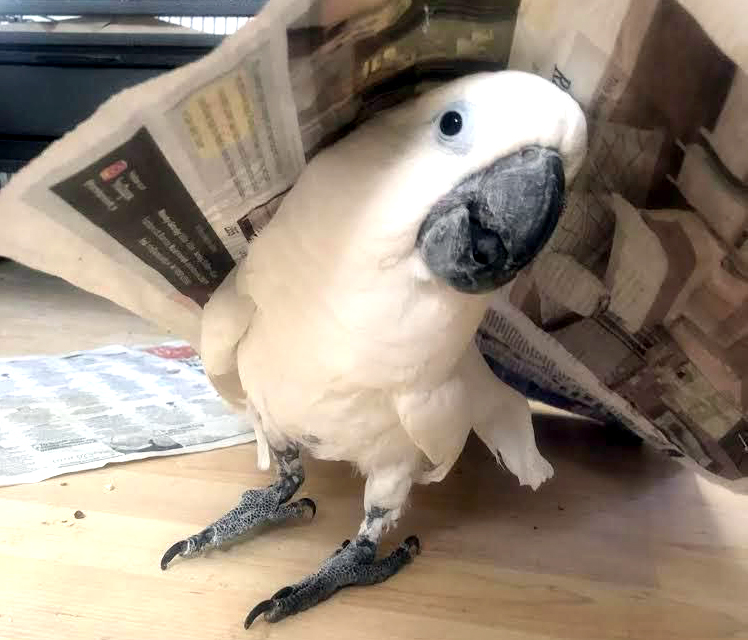Seasonal hormonal behaviour will be seen in a mature adult bird typically around spring-time, but exact time frames differ between species. As a parrot owner it is good practice to know your birds mating season along with species specific mating behaviours so that you can prepare to make changes that will help your bird through the season and prevent unwanted confusion.
In the wild parrots live in flocks and during spring-time will begin to court potential mates. Depending on the species some will keep their chosen mate for one or two seasons however other species will mate for a lifetime or until their chosen mate dies. A new mate will then be chosen.
It is important to remember that parrots are essentially still wild animals, they are not a domesticated species as they are not that far removed from their ‘wild’ relatives. One or two generations at best. Therefore the behaviours shown by our beloved companion parrots are almost identical to those who live freely in the wild.
Companion birds suffer greatly due to misunderstood hormonal behaviour, or as a result of a parrot who has inadvertently been ‘led on’ by its owner. Sadly it is not uncommon for an aggressive, sexually frustrated parrot to be rehomed as a result. Parrots that are not kept in pairs or flocks, or parrots hand raised by humans without interactions from others of its kind are more at risk of expressing increased levels of hormonal behaviour once they reach sexual maturity.
Causes of Hormonal Behaviour
- Seasonal Changes (Spring Fever!)- as a result of increased daylight.
- Diet.
- Touching your parrot in areas other than the head and feet. Wings and back are triggers to hormonal behaviour.
- Human-parrot bonding as a result of inappropriate handling.
- The parrot has found a potential mate e.g. a toy or another bird.
- Too much artificial light.
- Access to suitable nesting materials e.g. blankets, towels, cushion stuffing, paper, cardboard.
Signs of Hormonal Behaviours
- Excessive vocalization.
- Increased regurgitation.
- Masturbation.
- Aggression (biting) or being territorial to a ‘nest site’.
- Feather picking- some parrots will pull out or chew the feathers on their chest or between their legs. This is only seen in springtime.
- Flat backing- Seen in female parrots, she will crouch down with her wings drooped while panting heavily.
- Lifting of the tail and showing vent- seen in females.
- Mating displays- wings raised, tail feathers fanned out and strutting (males) , eye pinning. *
- Nest making or paper shredding.
- Egg Laying.
- Repetitive stereotypical behaviours.
STUDY YOUR BIRD SPECIES: mating displays will differ between species, for example Indian Ringneck Parakeets will perform a bow during mating season to help in winning over a potential mate.

How to Manage Hormonal Behaviour
- Limit your parrots intake of high calorie, high fat and simple carbohydrate foods. Foods such as these will trigger the increased production of hormones related to reproduction.
- Do not feed warm soft foods as this replicates the regurgitation that happens between mates.
- Do not offer foods out of your mouth.
- Remove any nesting materials such as blankets, paper towel, newspaper, toilet roll, pillowcases, parrot tepees ect. and stop cavity seeking. Keep draws closed, keep your parrot away from piles of laundry, and dark hidey-holes.
- Be extremely careful where you pet your bird. REMEMBER! You should only be petting your bird on the head and feet, NOWHERE ELSE as this will trigger hormonal behaviour.
- Ensure your bird gets no more than 12 hours of light. Your bird should be provided with 12 hours of darkness to roost and sleep.
- Remove all mirrors from your birds cage or aviary, a companion bird kept on its own will often try to bond with its reflection.
- Keep your parrot busy throughout the day, mental stimulation is an excellent deterrent in keeping hormonal behaviours in check.
DO NOT punish your bird for expressing hormonal behaviours. Hormonal behaviours are normal in sexually mature birds and the expression of hormonal behaviours in springtime should be expected. Hormonal behaviours should therefore be either deterred or ignored, punishing your bird will only add to their confusion and frustration.
What to do if your parrot is showing increased levels of Hormonal Behaviour
If your parrot is showing hormonal behaviour outside of spring that is becoming extremely difficult to manage, take your bird to a reputable avian veterinarian for a full assessment of your birds’ behaviours.
Veterinarian intervention
Before seeking veterinary intervention in the form of drugs your vet will ensure it is not the environment that is causing the increased level of hormonal behaviours. Behaviour altering drugs such as hormones, hormone antihistamines, psychoactive drugs, analgesics and anticonvulsants require a full behavioural diagnostic prior to administration as they are a last resort drug.
Another bird
Quite often the simple solution is to give your bird what it is naturally hardwired to want – a mate. Introducing a parrot of the opposite sex and providing that essential mating bond can decrease stereotypical behaviours in parrots and increase welfare. In the wild parrots live in flocks and will pair off once they reach sexual maturity. A mate ensures reproductive desires are kept in check.
However it is not a choice to consider lightly as you will need to take into account that it is most likely your bird will breed during the springtime and if this were the case you would have to ensure a suitable diet is provided and an egg management plan is in place to prevent unwanted young. Introducing another bird is also time consuming and there is always the risk.
Further Reading
https://www.adviespraktijkvoorvogels.nl/wp-content/uploads/2015/05/Welfare-Symposium-AAV-2010-Hand-rearing-of-parrots.pdf
https://www.sciencedirect.com/science/article/pii/S0168159117302617?casa_token=_z9qvpJwBAkAAAAA:BzbLj63QM2-V18hWQaLau8xY3BocbmoNAmQIf1me4cEQXGZ5owcQNfPXNth_gXf6p3p_B7lRGkA

